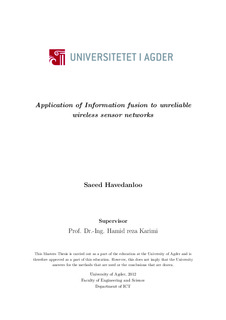| dc.description.abstract | Thesis is appropriated analyze to performance metric evaluation for decentralized distributed
detection sensor network strategy. Performance metric investigated a typical wireless sensor
network with respect to IEEE 802.15.4 standard. Distributed detection is considered with
present of the fusion node as long as clustering and non-clustering sensor network. The clusters
are organized uniform and non-uniform topology sensor networks with tree-based topologies
and hierarchical multi-level fusion centers. Fusion centers are acting as head of cluster for
decision making based on majority-like received signal strength (RSS) with comparison an
optimized threshold with concerning to channel influence. FCs decisions will forward to Access
point (AP). AP behaves similar as a fusion node with same channel affect but in next
level of fusing. Decision error probability at Fusion node is taken into the account based on
ideal and non-ideal channel with Channel State Information (CSI) impacts. Network average
delay, Reliability, Packet failure, Energy consumption, Network aggregation throughput are
considered as performance metric parameters versus packets generation rates and two 3,12
(dB) signal to noise ratio. An analytical Markov model IEEE 802.15.4 MAC layer is supposed
which characterized the slotted CSMA/CA mechanism of beacon enable mode. Markov model
drives the performance metric base on MAC and physical layer cross-layers method and Channel
State Information specifications. We assumed the performance metric is evaluated with
equation outcome from Markov model with mentioned topology with present of Fusion node.
With this combination, a theoretical performance evaluation framework is proposed. Application
of fuzzy fusion theory is considered in framework as well. Inference performed with
fuzzification, rule evaluation, combination or aggregation of rules, and deffuzification based on
most common methods of fuzzy logic Mamdani inference.The two inputs value are the distance
of a sensor node from fusion center node (cluster head) and its available RSSI as singnal to
noise ratio. Project figured out with simulations of Markov model with proposed framework.
Results represent significant enhancement on performance of network and accuracy of received
data to fusion nodes actions. | no_NO |
